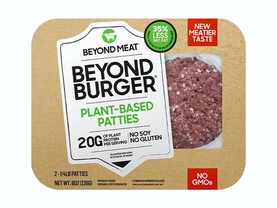Dublin-based agri tech firm Farmony sees potential for vertical farms to be developed in Northern Ireland.
Vertical farming is a form of controlled environment agriculture, where crops are grown indoors in stacked layers.
“Every day is a summer’s day in vertical farming because you effectively find the best growing conditions and then replicate it all year round,” said John Paul Prior from Farmony.
The company’s co-founder gave an online presentation to the Northern Ireland Institute of Agricultural Science (NIIAS) from a prototype unit in Ballycullen, Co Dublin, last week.
“We are growing produce that gives the best return on investment. We focus on leafy greens, herbs and microgreens,” Prior said.
The unit is based in two 40ft shipping containers which gives the equivalent output of five acres of conventional farmland. There are four layers of crops under LED lighting and water with the required nutrients flows through each level.
Prior said that consumer studies have shown the environmental benefit of vertical farming is its main selling point. It has the potential to drastically cut food miles, pesticides are not used at all, and it requires only 5% of the water used in conventional crop production.
Also, if energy from renewable sources is used, vertical farms are carbon-neutral, and there are no emissions from other gases, such as ammonia.
There is a wide range of vertical farming systems available worldwide, but the Farmony model has less automation and a higher labour requirement than most other units.
“A lot of vertical farms fail because they invest too heavily in technology. What we are after is a quick return on investment,” Prior maintained.
The smallest one-module unit from Farmony costs around £2,000, and a 17-module unit, which is equivalent to the two-shipping container unit in Ballycullen, costs around £75,000 to set up.
“I have heard it referred to as ‘a farm in a box’ or ‘a plug-in-and-play’ farm,” NIIAS members were told.
Payback
Figures were presented on the economics of setting up a 17-module vertical farm. It suggested a payback of around three years where the example farm was growing lettuce and basil, as well as microgreens, such as pea shoots and coriander.
Prior said that the most profitable crops are herbs and microgreens: “You only have to walk into your local supermarket to see the price that heads of lettuce sell at.”
It was made clear that establishing a profitable and reliable market for produce is the biggest issue facing prospective vertical farmers, although there is a range of outlets that can be explored.
“You could go to a wholesaler in foodservice, you could go direct to restaurants, you could go to retail which will require packaging and branding, or you could go straight to end consumers through local farmers’ markets,” Prior said.
Indoor agriculture to feed growing population
Vertical farming will have a key role in feeding a growing world population from a limited land area, according to David Farquhar from Intelligent Growth Solutions.
“This technology is going to contribute to global food production. It is going to be in the region of 20% to 25% of what people consume,” he said.
Edinburgh-headquarted Intelligent Growth Solutions is involved in developing vertical farms in Singapore as part of plans for the city state to increase its food self-sufficiency from 5% to 30%.The aim is for 20% of the fruit and vegetables consumed in Singapore to come from local greenhouses and vertical farms by 2030.
Farquhar said that vertical farming also offers a more reliable source of seedlings that can be used in conventional crop production.“Vertical farming is complementary to existing farmers and it is a way of producing far more efficient starter plants,” he said.






 This is a subscriber-only article
This is a subscriber-only article










SHARING OPTIONS: